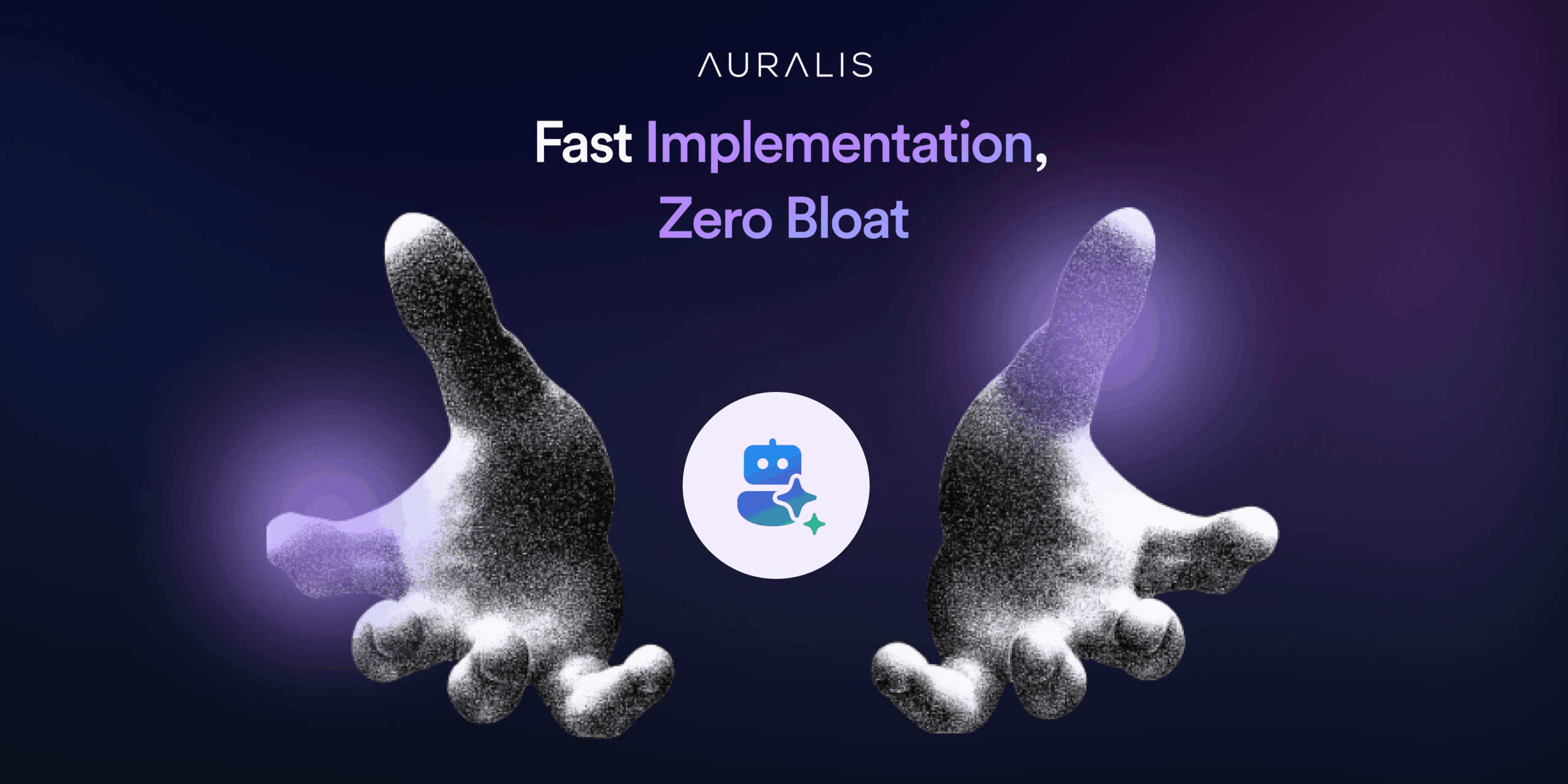Customer support is a critical function for businesses that want to maintain high levels of customer satisfaction and retention. While most companies can now be seen using AI and automation to serve their customers more proactively, the strategies implemented should be regularly monitored for performance.
In this post, we’re sharing the top customer support metrics we recommend for those using Auralis AI for automation to measure.
Table of Contents
What are customer support metrics?
Customer support or service metrics are a measure of your company’s state of customer satisfaction levels. This indicates whether the customers find it easy to interact with your business, would potentially buy more from you, or advocate your brand in their network. There are two key categories of customer support metrics:
- Operational Data (O-Data): Quantitative metrics like sales, customer numbers, and website traffic that show what has happened in your business. However, this lacks insights into customer motivations.
- Experience Data (X-Data): Qualitative insights from customer feedback that explain how and why customers feel about your brand. This provides context for improving business outcomes.
Why are customer support metrics important?
A good customer service and support automation solution will bring efficiency to your team. But if you’re not measuring the effectiveness of automation or AI, you could be potentially missing out on opportunities to engage customers on a deeper level.
Keeping track of customer support metrics can help your business answer:
- How customers feel about your products/ services
- How much handholding do they require to make the most of the purchases
- How well are the support teams able to assist them
- How easy/ comfortable do customers find interacting with your brand
- What marketing and sales efforts do you require to deliver your unique value proposition better
- Where your team requires assistance or additional resources
- How you can optimize the automated workflows and AI responses
Customer support metrics you must monitor
While the metrics you measure should be based on the KPIs set for customer support and service, here are some that will give you actionable insights:
1. Customer Satisfaction (CSAT)
Customer Satisfaction Score (CSAT) measures how satisfied customers are with the support they receive. This is often measured by asking customers to rate their experience after a query has been resolved.
- Why it matters: High CSAT scores directly reflect customer happiness, signaling successful interactions during support.
- How Auralis AI helps: With features like Live Chat Assist and Neural Navigator, Auralis AI ensures faster, more efficient responses. This leads to higher satisfaction and better CSAT scores.
2. Customer Effort Score (CES)
Less commonly measured, CES measures the effort a customer has to put in to get the help they need. The easier the process, the more likely they are to be satisfied.
- Why it matters: A low-effort experience encourages higher engagement and strengthens customer loyalty.
- How Auralis AI helps: By providing automated, context-driven support with In-App Messaging and Helpdesk Agent Assist, Auralis AI reduces customer effort.
3. Net Promoter Score (NPS)
NPS gauges customer loyalty by asking how likely they are to recommend your company to others. It has been a simple yet effective way to measure long-term customer satisfaction.
- Why it matters: NPS is a key indicator of customer loyalty and what may motivate word-of-mouth referrals.
- How Auralis AI helps: With Auralis AI handling up to 70% of customer inquiries quickly and efficiently, you get to improve customer experiences. Happy customers are 7x more likely to recommend your business to their network.
4. First Response Time (FRT)
FRT is the time it takes for a customer to receive the first reply from a customer support team. A fast response is indicative of how proactive your business is at offering support.
- Why it matters: A quick first response can prevent frustration and demonstrate that your company values their time.
- How Auralis AI helps: With 24/7 Live Chat Assist, Auralis AI ensures immediate responses.
5. Average Resolution Time
This metric measures how long it typically takes to resolve a customer’s issue from the time of first contact.
- Why it matters: Shorter resolution times reduce customer frustration and improve satisfaction rate.
- How Auralis AI helps: Features like Neural Navigator and Helpdesk Agent Assist allow Auralis AI to resolve common issues instantly. This speeds up the overall resolution time and improves customer experience.
6. First Contact Resolution Rate (FCR)
In addition to resolution time, FCR refers to measuring the percentage of issues resolved in the first interaction without requiring follow-ups. This is a clear indicator of the efficiency and effectiveness of your customer support.
- Why it matters: High FCR rates mean customers can move on from issues quickly; this helps improve satisfaction and also reduce operational costs.
- How Auralis AI helps: Auralis AI uses smart context-driven solutions to address queries on the first try. This reduces the need for escalation and additional interactions.
7. Ticket Volume and Backlog
As the name suggests, ticket volume measures the number of support requests coming in over a specific period (daily, weekly, monthly). Backlog on the other hand refers to unresolved tickets.
- Why it matters: Monitoring ticket volume and backlog helps ensure your support team is well-equipped to handle queries effectively.
- How Auralis AI helps: Auralis AI manages up to 70% of inquiries through automation. Companies can monitor incoming tickets to customize their automation workflows for further efficiency in the process.
8. Average Handle Time
Average Handle Time (AHT) refers to the average time an agent spends on each customer. This includes the entire conversation from first contact to final resolution.
- Why it matters: Lower handle times improve customer satisfaction by reducing their wait time for resolution.
- How Auralis AI helps: With Helpdesk Agent Assist, Auralis AI automates most of the support process. This can help resolve repetitive issues faster, letting agents focus on more complex issues.
9. Number of Interactions per Case
Going deeper into AHT, this metric tracks the number of interactions required to resolve an issue.
- Why it matters: Reducing the number of interactions required per case leads to higher FCR rates and increased customer satisfaction.
- How Auralis AI helps: By automating responses and streamlining the support process, Auralis AI cuts down on the number of inputs a customer is required to share to reach a solution.
10. Self-Service Usage
As you’re building out customer support collaterals and a knowledge base, it is important to measure how often your customers are putting them to use. This includes your FAQs, help center, how-tos, articles, and more.
- Why it matters: High self-service usage indicates that you have been able to anticipate customer requirements more effectively. This can also help reduce the load on your support team.
- How Auralis AI helps: Neural Navigator offers AI-driven self-service options that customers can engage with. This empowers them to solve issues independently by accessing the integrated resources from within the chat.
11. Preferred Communication Channel
Customer journeys are no longer linear. They can choose to interact with your business through email, chat, phone, social media, and other channels. Monitoring their channel of preference can help you stay better prepared.
- Why it matters: Understanding channel preferences allows your team to prioritize resources better and set up custom automation workflows.
- How Auralis AI helps: Auralis AI offers In-App Messaging, Live Chat assistance, and integrations with existing helpdesk software. This ensures that irrespective of the channel chosen, your customers queries are resolved in a timely manner.
12. Rate of Answered Calls
For companies offering phone support, this metric measures the percentage of incoming calls that are answered by the support team.
- Why it matters: A high rate of answered calls indicates good resource management and the ability to meet customer demand. But at the same time, it also highlights an opportunity to improve self-serve support and automation.
- How Auralis AI helps: Auralis AI primarily focuses on chat and ticket-based interactions. It helps reduce the overall number of phone call support queries, bringing efficiency to the team.
13. Customer Churn Rate
Customer churn measures the percentage of customers who stop engaging with your business. This could include using or purchasing your products/ services.
- Why it matters: Reducing churn is important for maintaining long-term profitability and business growth. Repeat customers spend 5x more than newly acquired ones.
- How Auralis AI helps: By offering fast, reliable support and improving customer experience with tools like Helpdesk Agent Assist, Auralis AI helps reduce churn rates. It ensures customers receive the support they need on the channel of their preference in the language of their choice.
14. Customer Retention Rate
This metric tracks the percentage of customers who repeatedly use your product/ service over a period of time. High retention rates are a sign of effective customer support and strong customer loyalty.
- Why it matters: Retained customers are more profitable and less costly to maintain than acquiring new customers – especially in competitive markets.
- How Auralis AI helps: Auralis AI’s fast response times and efficient issue resolution processes improve customer satisfaction. It’s ability to also provide insights into conversations shares insights into what you can do to boost retention.
15. Repurchase Rate
Repurchase rate is a measure of how often customers return to buy additional products or services. This can also include them reaching out to your customer support team for additional shopping assistance, or the upsell/ cross-sell made during query resolution.
- Why it matters: A higher repurchase rate indicates customer satisfaction and trust in the brand.
- How Auralis AI helps: By providing seamless customer support with tools like In-App Messaging and Live Chat Assist, Auralis AI improves the overall experience. It’s integration with your CMS, knowledge hub and other solutions from the technology stack also helps make personalized recommendations.
16. Agent Productivity
If you have equipped the team with AI and automation solutions, we also recommend measuring their overall productivity. This refers to how many issues they resolve per hour, day, or week.
- Why it matters: More productive agents reduce overall resolution time. This helps improve customer experience and also highlights new opportunities to optimize automation using the new learnings.
- How Auralis AI helps: Auralis AI empowers agents to be 5x more productive with features like Helpdesk Agent Assist. It lets them draft replies and automate ticket creation, letting them focus on more complex and high-priority cases.
Recommended read: How to balance AI and human agents for optimal customer support
Conclusion
It is important to note that the customer support metrics you measure are based on the objectives you have set for the department.
From analyzing why customers are unhappy, their intent, tone, and sentiment to how your custom automation workflow is performing, Auralis AI helps you derive actionable insights from the metrics above.
Want to know more? Book a demo today.



 10 min read
10 min read 

